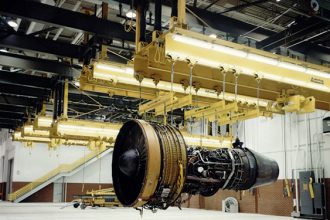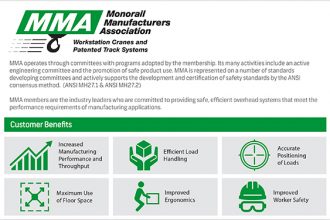Prior To Using A Workstation Crane, Operators Should Assess Its Condition Before Lifting Their First Load

For their own safety and the safety of those in the area, operators of workstation cranes should perform a pre-operational/pre-shift inspection to determine if any parts are damaged or require repairs. A series of 20 different areas should be reviewed, as detailed in MH27.2 Daily Operator Checklist for Enclosed Track Crane or Monorail Systems, a free document offered by the Monorail Manufacturers Association (MMA) of MHI. If any issues are discovered, the workstation crane should be locked-out/tagged-out of use and not operated until the problem has been addressed or repaired by a qualified service technician. This process ensures the proper, safe operation of such equipment and prevents a system failure that could injure the operator and other personnel working in the area. Additionally, to further help owners and operators of workstation cranes, MMA has published a series of recommended practices.
During the pre-operational workstation crane inspection, operators should follow this checklist of key items:
- Note the absence or presence of an out-of-service sign, indicating that the system was deemed unusable during a previous shift and has not yet been repaired.
- If the system utilizes a control device, confirm that all travel motions correspond to the controller’s direction markings.
- Determine that limit switches (if incorporated into the system) are functioning correctly.
- Verify the proper deceleration of all travel motions, that stopping distances are normal, and that no excessive drift occurs.
- Confirm that any required attachment clamps or brackets are both present and properly installed.
- Examine the trolleys and bridge end trucks for obvious damage, cracks, deformation or twisting. Additionally, check for damaged bumpers.
- Determine that no components are loose and verify that all bolts are installed, tight and not missing.
- Check end stop assemblies to confirm that bolts and nuts are present and securely installed.
- Confirm that none of the rail flanges or sliding surfaces are bent downward or worn beyond the manufacturer’s specified limits.
- Examine all system welds for cracks or defects.
- Look carefully for any oil or grease leakage on the drive systems or on the floor beneath the drives.
- Listen for any unusual sounds from the trolley or bridge motions.
- Check that all capacity, warning, and safety labels are intact and legible.
- Confirm that the maximum load capacities of the hoist(s) and/or trolley(s) do not exceed the maximum capacity of the system.
- Test both trolley and bridge travel to ensure they can traverse the entire length of the rail without snags.
- Examine the system’s support structure, looking for bent or otherwise damaged hanger assemblies, to confirm overall operational stability.
- Determine if any unauthorized modifications have occurred.
- Evaluate the work area for accumulation of materials and for poor lighting, both of which can cause trips and slipping.
- Assess the hoist following the appropriate checklist for electric powered and air powered hoists, hand chain hoists, and lever hoists, published by the Hoist Manufacturers Institute (HMI).
If, during the pre-shift inspection, an operator notes any issues the workstation crane should promptly be removed from service. Completed checklists should be collected and kept on file within the facility as a record that the assessments are being performed properly and on schedule, as well as that the equipment is operating both effectively and safely.
Want to learn more ways workstation cranes can help your workers be both safer and more productive? The members of the Monorail Manufacturers Association (MMA) are the industry’s leading suppliers of monorails and workstation crane systems. The group offers a variety of resources—including a product certification program, recommended practices for workstation cranes and patented track systems, and more — via its website at www.MHI.org/MMA.



